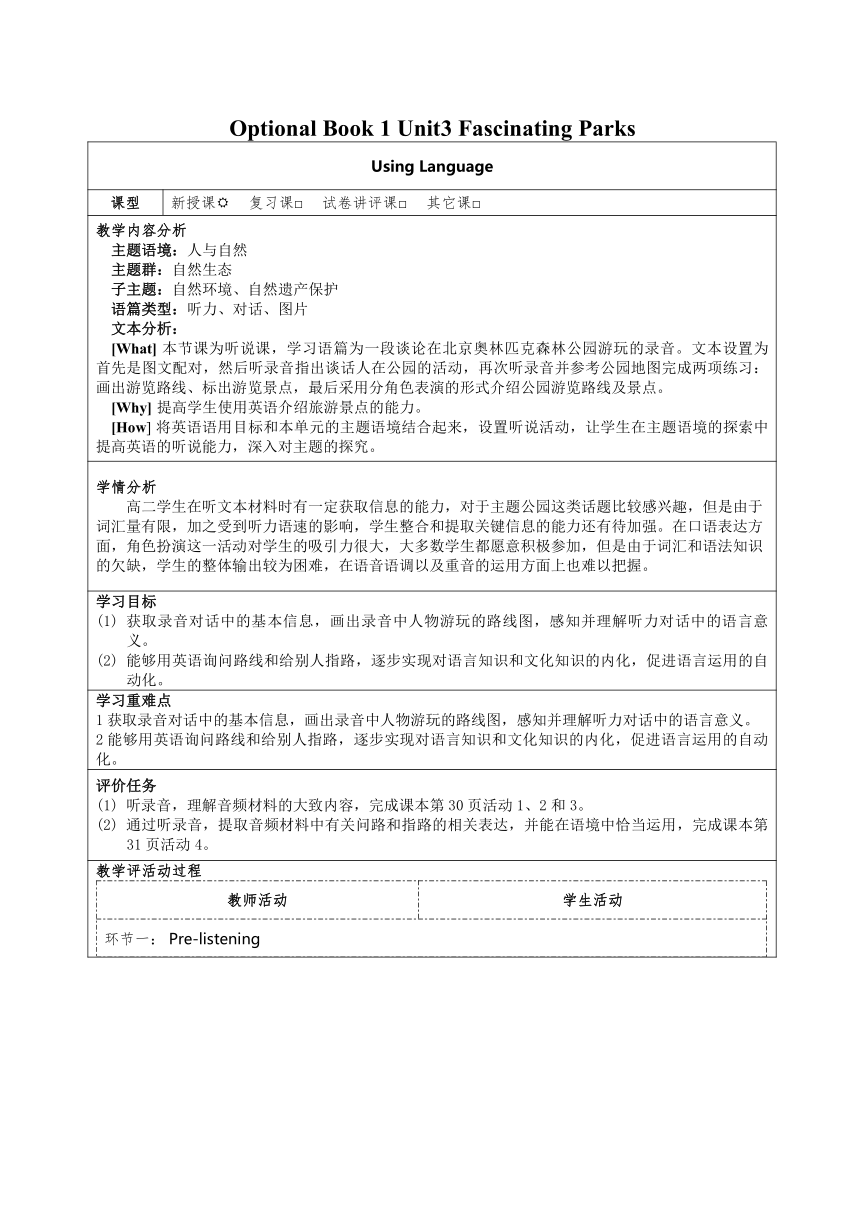人教版(2019)选择性必修 第一册Unit3 Fascinating Parks Using Language教学设计(表格式)
文档属性
| 名称 | 人教版(2019)选择性必修 第一册Unit3 Fascinating Parks Using Language教学设计(表格式) |  | |
| 格式 | docx | ||
| 文件大小 | 26.4KB | ||
| 资源类型 | 教案 | ||
| 版本资源 | 人教版(2019) | ||
| 科目 | 英语 | ||
| 更新时间 | 2024-12-23 14:51:01 | ||
图片预览

文档简介
Optional Book 1 Unit3 Fascinating Parks
Using Language
课型 新授课 复习课□ 试卷讲评课□ 其它课□
教学内容分析 主题语境:人与自然 主题群:自然生态 子主题:自然环境、自然遗产保护 语篇类型:听力、对话、图片 文本分析: [What] 本节课为听说课,学习语篇为一段谈论在北京奥林匹克森林公园游玩的录音。文本设置为首先是图文配对,然后听录音指出谈话人在公园的活动,再次听录音并参考公园地图完成两项练习:画出游览路线、标出游览景点,最后采用分角色表演的形式介绍公园游览路线及景点。 [Why] 提高学生使用英语介绍旅游景点的能力。 [How] 将英语语用目标和本单元的主题语境结合起来,设置听说活动,让学生在主题语境的探索中提高英语的听说能力,深入对主题的探究。
学情分析 高二学生在听文本材料时有一定获取信息的能力,对于主题公园这类话题比较感兴趣,但是由于词汇量有限,加之受到听力语速的影响,学生整合和提取关键信息的能力还有待加强。在口语表达方面,角色扮演这一活动对学生的吸引力很大,大多数学生都愿意积极参加,但是由于词汇和语法知识的欠缺,学生的整体输出较为困难,在语音语调以及重音的运用方面上也难以把握。
学习目标 获取录音对话中的基本信息,画出录音中人物游玩的路线图,感知并理解听力对话中的语言意义。 能够用英语询问路线和给别人指路,逐步实现对语言知识和文化知识的内化,促进语言运用的自动化。
学习重难点 1获取录音对话中的基本信息,画出录音中人物游玩的路线图,感知并理解听力对话中的语言意义。 2能够用英语询问路线和给别人指路,逐步实现对语言知识和文化知识的内化,促进语言运用的自动化。
评价任务 听录音,理解音频材料的大致内容,完成课本第30页活动1、2和3。 通过听录音,提取音频材料中有关问路和指路的相关表达,并能在语境中恰当运用,完成课本第31页活动4。
教学评活动过程 教师活动学生活动环节一: Pre-listening教师活动 1. Look at the photos taken in Beijing Olympic Forest Park. Match them with the activities below. Write the correct letter in each circle. 2. Discuss the questions in groups. Have you ever been to Beijing Olympic Forest Park Which activities above do you like 学生活动 Match the pictures and discuss the questions in groups. Suggested answers: BF AC ED设计意图: 在学习之前,呈现有关北京奥林匹克森林公园的图片,图文对应并简单讨论自己喜欢的北京奥林匹克森林公园里面的活动,调动多种感觉器官参与学习活动,从而能引导学生快速进入主题学习。环节二:Listen and tick 教师活动 Explain the listening strategy to students to make them understand what it is. Listen to their conversation.Tick which activities they are going to do above.学生活动 Understand the listening strategy, that is, listening for directions. Listen the conversation and answer the question.设计意图: 播放录音,获取对话中人物在奥林匹克森林公园中的游览路线以及参与的活动,并勾出他们要做的活动。这个过程有助于提高学生听力理解的能力。 环节三:Draw and mark教师活动 Look at the map. Listen to the conversation again and finish the activities below. Draw the route that Jake, Linlin, and Yuhui will take. Mark the places they will visit on the map below.学生活动 Listen to the conversation and draw a brief route map. Mark the place in the map.设计意图: 该活动的主要目的是让学生一边听一边画出路线图,然后在地图上标出他们将要参观的地点,这个过程需要学生边听边读地图,进行分析和判断信息。环节四:Talk about how to get to places in the park教师活动 1. Language learning. Ask students to try to read the following structures about asking for and giving directions over and over again until they can speak fluently. 2. Role-play. Work in pairs. Role-play visiting the park. Take turns giving directions to different places in the park. 学生活动 Read related expressions about asking for and giving directions. Work in pairs. Help others find directions to different places in the park.设计意图: 在口语对话之前,帮助学生收集一些问路和指路的词汇和语句,学生通过思考和积累,获取这些语用知识,为口语活动提供背景常识和语言结构,使得学生有话可说。然后分角色表演游览公园,轮流交换问路和指路,在这个过程中,学生逐步实现对语言知识和文化知识的内化,促进语言运用的自动化,有助于学生将知识转化为能力。环节五:Write教师活动 Write a passage about a park, focusing on the route to the park and a scenic spot.学生活动 Write a short passage by using related expressions about asking for and giving directions. 设计意图: 让学生写一篇关于介绍公园路线和景点的短文,目的是让学生在新的语境中表达自己的观点、情感等,实现深度学习,促进能力向素养转变。
板书设计 Using Language A rent a cycle New words B walk through an underwater corridor fixed C rent a pedal boat rental D watch a fountain performance cycle E go to a children’s ride ahead F look at flowers
作业与拓展学习设计 Make a dialogue to give directions about your familiar places. You may use the expressions that you have learned to help you.(80-120 words)
特色学习资源分析、技术手段的应用说明 利用多媒体呈现图片,引入相关有关公园路线的话题。此外,利用白板播放音频,进行听力教学。
教学反思与改进 学生能根据听力材料提取部分有关问路和指路的信息,但由于听力语速较快以及词汇量储备不足,一些学生不能根据录音材料获取关键信息。因此,在今后的课堂上,要加大对学生获取关键信息的指导,同时继续督促学生拓展词汇量。
— 4 —
Using Language
课型 新授课 复习课□ 试卷讲评课□ 其它课□
教学内容分析 主题语境:人与自然 主题群:自然生态 子主题:自然环境、自然遗产保护 语篇类型:听力、对话、图片 文本分析: [What] 本节课为听说课,学习语篇为一段谈论在北京奥林匹克森林公园游玩的录音。文本设置为首先是图文配对,然后听录音指出谈话人在公园的活动,再次听录音并参考公园地图完成两项练习:画出游览路线、标出游览景点,最后采用分角色表演的形式介绍公园游览路线及景点。 [Why] 提高学生使用英语介绍旅游景点的能力。 [How] 将英语语用目标和本单元的主题语境结合起来,设置听说活动,让学生在主题语境的探索中提高英语的听说能力,深入对主题的探究。
学情分析 高二学生在听文本材料时有一定获取信息的能力,对于主题公园这类话题比较感兴趣,但是由于词汇量有限,加之受到听力语速的影响,学生整合和提取关键信息的能力还有待加强。在口语表达方面,角色扮演这一活动对学生的吸引力很大,大多数学生都愿意积极参加,但是由于词汇和语法知识的欠缺,学生的整体输出较为困难,在语音语调以及重音的运用方面上也难以把握。
学习目标 获取录音对话中的基本信息,画出录音中人物游玩的路线图,感知并理解听力对话中的语言意义。 能够用英语询问路线和给别人指路,逐步实现对语言知识和文化知识的内化,促进语言运用的自动化。
学习重难点 1获取录音对话中的基本信息,画出录音中人物游玩的路线图,感知并理解听力对话中的语言意义。 2能够用英语询问路线和给别人指路,逐步实现对语言知识和文化知识的内化,促进语言运用的自动化。
评价任务 听录音,理解音频材料的大致内容,完成课本第30页活动1、2和3。 通过听录音,提取音频材料中有关问路和指路的相关表达,并能在语境中恰当运用,完成课本第31页活动4。
教学评活动过程 教师活动学生活动环节一: Pre-listening教师活动 1. Look at the photos taken in Beijing Olympic Forest Park. Match them with the activities below. Write the correct letter in each circle. 2. Discuss the questions in groups. Have you ever been to Beijing Olympic Forest Park Which activities above do you like 学生活动 Match the pictures and discuss the questions in groups. Suggested answers: BF AC ED设计意图: 在学习之前,呈现有关北京奥林匹克森林公园的图片,图文对应并简单讨论自己喜欢的北京奥林匹克森林公园里面的活动,调动多种感觉器官参与学习活动,从而能引导学生快速进入主题学习。环节二:Listen and tick 教师活动 Explain the listening strategy to students to make them understand what it is. Listen to their conversation.Tick which activities they are going to do above.学生活动 Understand the listening strategy, that is, listening for directions. Listen the conversation and answer the question.设计意图: 播放录音,获取对话中人物在奥林匹克森林公园中的游览路线以及参与的活动,并勾出他们要做的活动。这个过程有助于提高学生听力理解的能力。 环节三:Draw and mark教师活动 Look at the map. Listen to the conversation again and finish the activities below. Draw the route that Jake, Linlin, and Yuhui will take. Mark the places they will visit on the map below.学生活动 Listen to the conversation and draw a brief route map. Mark the place in the map.设计意图: 该活动的主要目的是让学生一边听一边画出路线图,然后在地图上标出他们将要参观的地点,这个过程需要学生边听边读地图,进行分析和判断信息。环节四:Talk about how to get to places in the park教师活动 1. Language learning. Ask students to try to read the following structures about asking for and giving directions over and over again until they can speak fluently. 2. Role-play. Work in pairs. Role-play visiting the park. Take turns giving directions to different places in the park. 学生活动 Read related expressions about asking for and giving directions. Work in pairs. Help others find directions to different places in the park.设计意图: 在口语对话之前,帮助学生收集一些问路和指路的词汇和语句,学生通过思考和积累,获取这些语用知识,为口语活动提供背景常识和语言结构,使得学生有话可说。然后分角色表演游览公园,轮流交换问路和指路,在这个过程中,学生逐步实现对语言知识和文化知识的内化,促进语言运用的自动化,有助于学生将知识转化为能力。环节五:Write教师活动 Write a passage about a park, focusing on the route to the park and a scenic spot.学生活动 Write a short passage by using related expressions about asking for and giving directions. 设计意图: 让学生写一篇关于介绍公园路线和景点的短文,目的是让学生在新的语境中表达自己的观点、情感等,实现深度学习,促进能力向素养转变。
板书设计 Using Language A rent a cycle New words B walk through an underwater corridor fixed C rent a pedal boat rental D watch a fountain performance cycle E go to a children’s ride ahead F look at flowers
作业与拓展学习设计 Make a dialogue to give directions about your familiar places. You may use the expressions that you have learned to help you.(80-120 words)
特色学习资源分析、技术手段的应用说明 利用多媒体呈现图片,引入相关有关公园路线的话题。此外,利用白板播放音频,进行听力教学。
教学反思与改进 学生能根据听力材料提取部分有关问路和指路的信息,但由于听力语速较快以及词汇量储备不足,一些学生不能根据录音材料获取关键信息。因此,在今后的课堂上,要加大对学生获取关键信息的指导,同时继续督促学生拓展词汇量。
— 4 —
